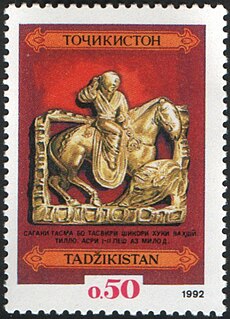
Tajikistan, officially the Republic of Tajikistan, is a mountainous, landlocked country in Central Asia with an area of 143,100 km2 (55,300 sq mi) and an estimated population of 8.7 million people as of 2016. It is bordered by Afghanistan to the south, Uzbekistan to the west, Kyrgyzstan to the north, and China to the east. The traditional homelands of the Tajik people include present-day Tajikistan as well as parts of Afghanistan and Uzbekistan.

Tajikistan harkens to the Samanid Empire (875–999). The Tajik people came under Russian rule in the 1860s. The Basmachi revolt broke out in the wake of the Russian Revolution of 1917 and was quelled in the early 1920s during the Russian Civil War. In 1924 Tajikistan became an Autonomous Soviet Socialist Republics of the Soviet Union, the Tajik ASSR, within Uzbekistan. In 1929 Tajikistan was made one of the component republics of the Soviet Union – Tajik Soviet Socialist Republic – and it kept that status until gaining independence 1991 after the dissolution of the Soviet Union.
The politics of Tajikistan takes place in a framework of a presidential republic, whereby the President is both head of state and head of government, and of a multi-party system. Legislative power is vested in both the executive branch and the two chambers of parliament.

Since independence, Tajikistan gradually followed the path of transition economy, reforming its economic policies. With foreign revenue precariously dependent upon exports of cotton and aluminium, the economy is highly vulnerable to external shocks. Tajikistan's economy also incorporates a massive black market, primarily focused on the drug trade with Afghanistan, and heroin trafficking in Tajikistan is estimated to be equivalent 30-50% of national GDP as of 2012. In fiscal year (FY) 2000, international assistance remained an essential source of support for rehabilitation programs that reintegrated former civil war combatants into the civilian economy, thus helping keep the peace. International assistance also was necessary to address the second year of severe drought that resulted in a continued shortfall of food production. Tajikistan's economy grew substantially after the war. The gross domestic product (GDP) of Tajikistan expanded at an average rate of 9.6% over the period of 2000-2007 according to the World Bank data. This improved Tajikistan's position among other Central Asian countries, which have degraded economically ever since. As of August 2009, an estimated 60% of Tajikistani citizens live below the poverty line. The 2008 global financial crisis has hit Tajikistan hard, both domestically and internationally. Tajikistan has been hit harder than many countries because it already has a high poverty rate and because many of its citizens depend on remittances from expatriate Tajikistanis.

The Armed Forces of the Republic of Tajikistan is the national military of the Republic of Tajikistan. It consists of National Army, Mobile Forces, Air Force, Presidential National Guard, border and internal troops. There are also significant Russian forces in the country, principally the 201st Motor Rifle Division.

Dushanbe is the capital and largest city of Tajikistan. Dushanbe means Monday in the Tajik language, the local language. It was named this way because it grew from a village that originally had a popular market on Mondays. As of 2016, Dushanbe had a population of 802,700.

Tajik or Tajiki, also called Tajiki Persian, is the variety of Persian spoken in Tajikistan and Uzbekistan. It is closely related to Dari Persian. Since the beginning of the twentieth century and collapse of the Soviet Union, Tajik has been considered by a number of writers and researchers to be a variety of Persian. The popularity of this conception of Tajik as a variety of Persian was such that, during the period in which Tajik intellectuals were trying to establish Tajik as a language separate from Persian language, Sadriddin Ayni, who was a prominent intellectual and educator, made a statement that Tajik was not a bastardized dialect of Persian. The issue of whether Tajik and Persian are to be considered two dialects of a single language or two discrete languages has political sides to it.

Emomali Rahmon is a Tajikistani politician who has served as President of Tajikistan since 1992.

The Tajik Soviet Socialist Republic, also commonly known as Soviet Tajikistan and Tajik SSR, was one of the constituent republics of the Soviet Union which existed from 1929 to 1991 located in Central Asia.

The People's Democratic Party of Tajikistan is a political party in Tajikistan. It is currently the ruling political party in Tajikistan. It is the largest political party in the country, the so-called "party of power". Members of the PDPT occupy 51 seats out of 63 in the Majlisi Oli of the Republic of Tajikistan — the parliament of Tajikistan.

Kulob, also Kulyab, is a city in Kulob District, Khatlon Province, Tajikistan. Located 203 km south-east of the capital Dushanbe on the Yakhsu River, it is one of the largest cities in the country and has an estimated population of 100,000. The town is served by Kulob Airport.

The Kuhistani Badakhshan Autonomous Region (Tajik: Вилояти Мухтори Кӯҳистони Бадахшон, Viloyati Muxtori Köhistoni Badaxshon; also known as Gorno-Badakhshan is an autonomous region in eastern Tajikistan. Located in the Pamir Mountains, it makes up 45% of the land area of the country but only 3% of its population.

The Tajikistani Civil War, also known as the Tajik Civil War or the War in Tajikistan, began in May 1992 when regional groups from the Garm and Gorno-Badakhshan regions of Tajikistan rose up against the newly-formed government of President Rahmon Nabiyev, which was dominated by people from the Khujand and Kulyab regions. The rebel groups were led by a combination of liberal democratic reformers and Islamists, who would later organize under the banner of the United Tajik Opposition. The government was supported by Russian border guards.

Sughd Region is one of the four administrative divisions and one of the three provinces that make up Tajikistan. Centered in the historical Sogdiana, it is located in the northwest of the country, with an area of some 25,400 square kilometers and a population of 2,132,100, up from 1,870,000 according to the 2000 census and 1,558,000 in 1989. It was founded in 1924 as part of Uzbek SSR and transferred to Tajik SSR by Soviet Communists in 1929. Today, the region is still home to a large number of ethnic Uzbeks.

The bilateral relations between the Republic of India and the Republic of Tajikistan have developed considerably owing to both nations' co-operation on security and strategic issues. India has set up its first overseas military base Farkhor in Tajikistan. India also assisted in building Ayni hospital.

Russia–Tajikistan relations is the bilateral relationship between the Russian Federation and Tajikistan.

This is a survey of the postage stamps and postal history of Tajikistan.

Visitors to Tajikistan must obtain a visa from one of the Tajikistan diplomatic missions unless they come from one of the visa exempt countries or countries whose citizens are eligible for an electronic visa or a visa on arrival.

The Tajik Air Force is the Tajikistan armed forces aerial military service branch, which currently consists of 20 aircraft. The force engages in search and rescue missions, and military raids.
The Military ranks of Tajikistan are the military insignia used by the Armed Forces of the Republic of Tajikistan. Being a former member of Soviet Union, Tajikistan shares a rank structure similar to that of Russia. Tajikistan is a landlocked country, and does therefore not possess a navy.



















